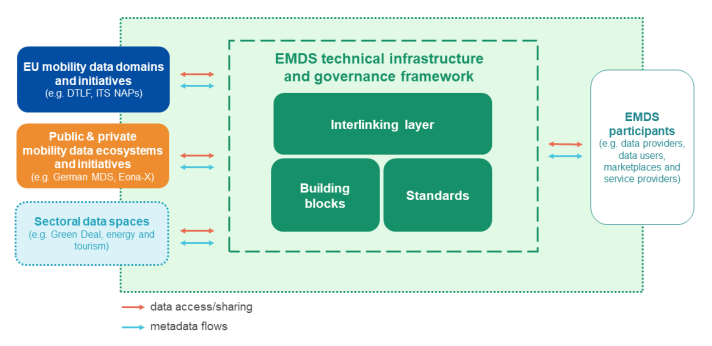The EU must move quickly towards a sustainable, smart and inclusive mobility and transport sector in the interests of the environment, competitiveness and resilience. As set out in the Commission’s Sustainable and Smart Mobility Strategy (SSMS), digitalisation can help drive this transition, establishing a truly efficient and interconnected multimodal transport system for both passengers and freight that will help the EU to meet its European Green Deal and A Europe fit for the digital age goals.
The SSMS and the European strategy for data both call for a common European mobility data space (EMDS) to facilitate access, pooling and sharing of data from existing and future transport and mobility data sources.
While vast quantities of relevant data are already generated (often driven by requirements under EU transport legislation), the transport and mobility data landscape is fragmented. Addressing this will allow the EU to innovate more and truly benefit from digitalisation.
Data-driven innovation has the potential to improve the way transport systems are used, and to make multimodal mobility more efficient, for example by providing real-time information on delays and alternative connections.
The EMDS approach
On 29 November 2023, the Commission adopted a Communication on the EMDS outlining the objectives, main components, supporting measures, milestones and proposed way forward.
The EMDS will not be a single database of all EU mobility and transport data. It will instead offer a framework for interlinking and federating many different transport-data ecosystems that are heterogeneous and often difficult to discover or access, while also proposing recommendations for further harmonisation and interoperability. The EMDS will build on and complement European cross-sectoral data legislation (e.g. the Data Governance Act and the Data Act). It will take account of data-sharing mechanisms set up or proposed in existing passenger and freight transport ecosystems and legislation (e.g. the ITS Directive establishing the National Access Points), expert groups such as the Digital Transport and Logistics Forum (DTLF) and other national or private initiatives.
The EMDS framework will have technical (e.g. infrastructure elements) and governance dimensions (e.g. a set of rules, procedures, roles and responsibilities). In accordance with EU legislation, the path towards an EMDS will begin with defining the building blocks and an interlinking layer (The interlinking layer will enable the interconnectivity of existing and emerging mobility and transport data spaces and domains. It will notably facilitate the discoverability and accessibility of data from those data spaces and domains. In this way, this layer is expected to become the core of the EMDS.), as well as standards where necessary. The resulting structure will facilitate data access, reuse and sharing in a federated, trusted and secure environment, between mobility and transport data ecosystems and their stakeholders, and with data spaces from other sectors.
Benefits
Passengers, commuters and travellers will benefit from an improved travel experience thanks to more efficient transport systems and reduced travel times. Access to real-time data will keep them informed of the transport situation, traffic conditions and potential delays, allowing them to plan journeys better. Many service providers and public authorities already offer real-time updates, but more comprehensive data-sharing would raise the quality of services and facilitate more system integration, multimodality, road safety and sustainability.
Enabling mobility and transport data sharing can significantly benefit Member States and public authorities by making it easier to base transport policy-making on data, and to target implementation. It can help boost cross-border connectivity, improving cooperation between Member States, facilitating seamless travel and trade within the EU and helping to increase economic growth. Simplified access to comprehensive mobility and transport data can also help Member States make more informed decisions about infrastructure development and transportation planning, leading to more efficient and optimised systems.
Market actors can benefit from new business and innovation opportunities to develop innovative transportation services and technologies. Collaboration through simplified data access and sharing is conducive to the creation of partnerships and the integration of services into broader mobility ecosystems. Increased data-sharing also improves coordination between private and public actors. Small and medium-sized enterprises (SMEs) in particular stand to benefit from this. Advances in data-sharing also allow private actors to use real-time information to optimise operations and resource allocation, resulting in more efficient and cost-effective operations.
Supportive actions
To support the creation of the EMDS, the Digital Europe Programme (DIGITAL) and the Connecting Europe Facility (CEF) make available funds for preparatory and deployment actions:
- A 12-month Coordination and Support Action (EUR 1 million, DIGITAL) was completed in September 2023. It focused on the mapping of existing mobility data domains, defining the first building blocks and identifying gaps.
- A deployment action was launched in November 2023 and will run for three years (EUR 8 million, DIGITAL), with a focus on data-sharing use-cases linked to traffic data and urban mobility.
- A six-month Proof-of-Concept (DIGITAL) initiative was launched in January 2024 to explore how personal data should be managed in the realm of the EMDS.
- A 12-month technical assistance study (EUR 500 000, CEF) was launched in January 2024 with a focus on the technical and governance aspects of EMDS.
- A call for proposals (EUR 15 million, DIGITAL, project duration 48 months), will support the implementation of a Multi-Country Project on European common data infrastructure and services, with a focus on the mobility and transport sector.
Building the EMDS will be a dynamic process. Feedback and support from all stakeholders in the EU mobility and transport sector will be fundamental to achieving the goals of the EMDS. The data space should be built primarily for and by mobility and transport stakeholders, responding to their needs and leveraging existing and emerging initiatives across the EU.

